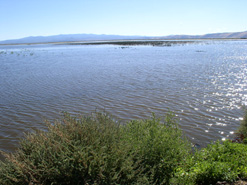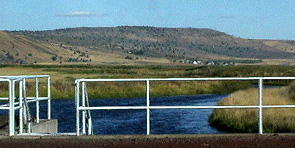KBC Home
Tour Table
of Contents
o Refuge
 |
Fran Maiss: This is a six hundred acre block that, as John mentioned, last fall was in crop land one hundred percent. What we did was we utilized ourselves, and the Bureau of Reclamation and TID jointly utilized some of the existing infrastructure levies that were here already. And we raised a road on that side and we raised this road into a levy system so we have 300 acres on each side. We put the water in here last December or January, so what you have is a fairly instantaneous response of both wetland vegetation and wildlife. |
| The neat thing about this is that it is not only providing a
habitat thatís a unique habitat on this refuge, which is a shallow marsh, but also one of its main functions, it's
an integrated pest management
technique to cleanse the soil of two species of nematodes that effect barley
and potatoes. I donít know Harry, are you going to talk a little bit about
this? photo on right: l-r Carlson, Maiss, Crisp and Gearheart |
 |
|
Dr Harry Carlson, left, speaks regarding the refuges |
Carlson: I think it is obvious perhaps what the wildlife benefits of this rotation scheme seem to be, I mean this is pretty productive marsh. The waterfowl use will just increase as the migration starts this fall and youíll see tremendous amount of duck use days out of these marshes. The wildlife benefits are really obvious. Whatís maybe less obvious are some of the benefits in agriculture and why we first purposed this kind of a notion as a win-win for both agriculture and the refuge in the lease lands. |
Two nematodes that Fran mentioned, the barley root-knot nematode and the Columbia root-knot nematode, are extremely serious pests of potatoes and cereal grains. The barley root-knot nematode is particularly troublesome if you have continuous cereal grains without a break in them (without rotation with other crops). This controls the nematodes if we go through a year of flooding like this, but I donít want to mislead you. Itís very, very difficult to drown an aquatic insect. So we're not drowning the nematodes. What has happened in the case of these two nematodes, they have a very narrow host range and we're not providing any food source. The populations are dramatically decreasing. We have another organism that is an extreme problem in the Tule Lake area and anywhere you grow onions and thatís white rot. In fact the presence of white rot in your soil almost eliminates the possibility of growing onions or garlic in that field.
Back on bus:
John Crawford: "From the D Plant, water flows by gravity thru the tunnel, thru the mountain into the Lower Klamath Refuge, and thatís what keeps this from being a sump, and keeps this from being a catch-all for nutrients and everything else that may be bad in the system, and allows a flow-thru system and keeps the water quality at least as good as the water that comes into the Project.
 Straits Drain |
This is Sheepy Ridge right here. This is the end of the Straits Drain as you look to the front of the bus youíll see water that is being pumped out of the Straits Drain and making itís way over here thru the head gates directly into the Klamath River. The water that you see in the canal over here is being diverted out and is being used to irrigate Klamath Drainage District. But this is the end result and youíve got water going both ways, but this is what keeps us from being a closed system. |
And the water is entering the river here and the quantities of water that enter here are significant. They are up to one hundred thousand acre feet annually that go back to the river out of the agricultural system.
QUESTION: How about the other way?
Crawford: Well here in KDD they use about 50 thousand probably. Itís part of the 3 to 4 hundred thousand that this entire Project and refuge divert annually.
QUESTION: So a large volume of that would come back into the system?
Crawford: Right.
Maiss: You know whatís interesting John is, with these sporadic deliveries to Lower Klamath in the last three years, we really havenít discharged any significant amounts of water out of the Lower Klamath in the past three years. The last time we let a large amount of water out was April of 2000. In 2001 we got about 50% of our normal deliveries and we used it all. In 2002 we got about 50% of normal deliveries and we used it all. Last spring was very wet and we just filled everything, but we did not discharge anything that winter either. So we've really gone three winters without having discharged any appreciable amounts of water out of the Lower Klamath. Weíve just been recirculating it through our wetlands. You can do that in the short run but in the long run itís going to hurt you because youíre going to salt up. So weíve got to get adequate deliveries back to that refuge one way or another.
STATEMENT: Youíve acquired more land too.
Maiss: But thatís not even in the equation. Thatís not in that equation.
Crawford: And thatís why we all have to be very careful when we talk about agricultural conservation and what that means to the Project and to the refuges. Because it means something very different to the Project than it means to the refuges, and the more efficient we become and the more water we conserve, the more concern we have for a continuing water supply that is consistent for the refuges. Itís an issue that we all have to deal with and nobody wants the refuges dry. The Klamath Project irrigators donít want the refuges dry, the American public does not want the refuges dry, and they are not going to let that happen. But without agricultural cooperation and support, even the things that Fran talks about arenít possible. They are so reliant on us as their primary source of water, and we want to see to it that that continues and we donít want to conserve ourselves out of that business.
Maiss: 2/3 of our water comes through the hill historically, and one third is a direct diversion through the ADY Canal, and the last three years weíve not been allowed to take that direct diversion so the other two thirds is even more important. So weíve really not had adequate supplies to that refuge in three years.
QUESTION: Let me understand. You say you can take water back this way at high points, right?
Crawford: They can cover about 1/3 of their need, but just gravity disallows them to deliver.
Maiss: The size of the canal at the rate it delivers it, and the levels of the wetland, because it all slopes, the Lower Klamath slopes, you saw it subdivided into 34 units, what comes out of the ADY canal can service about 1/3 of the refuge. The other 2/3s has to come from the Tule Lake side.
QUESTION: Your talking about over the season?
Maiss: Over the whole year, and the 1/3 that we usually take is in the
summertime to sustain what we want to have in permanent marshes to offset
evaporation. In the fall is when we really take the agricultural water, August,
September, October, and then into November the winter rains come, and thatís when it all
comes through D plant and that goes to our seasonal marshes.
______________________________________________________
END OF TOUR